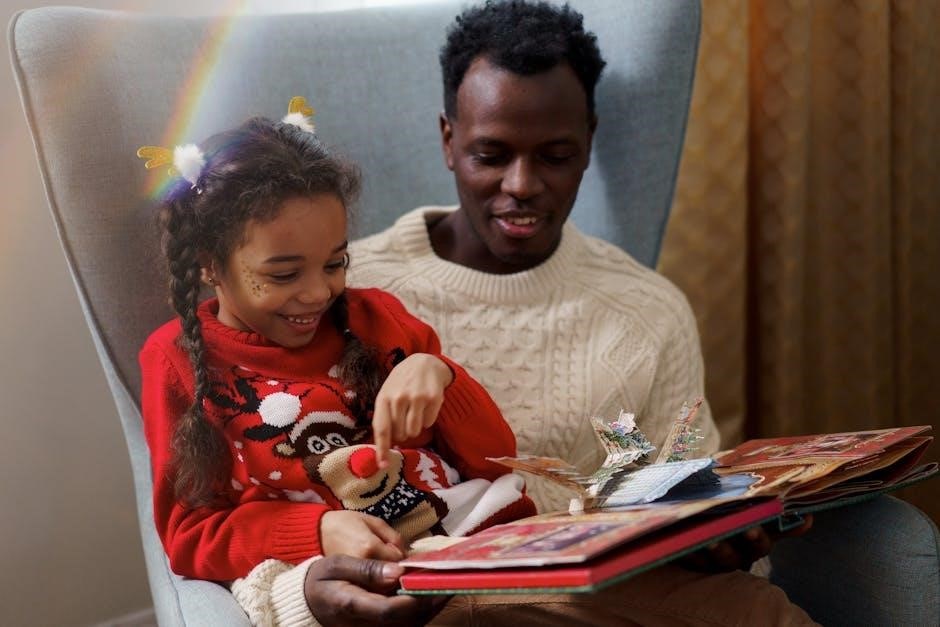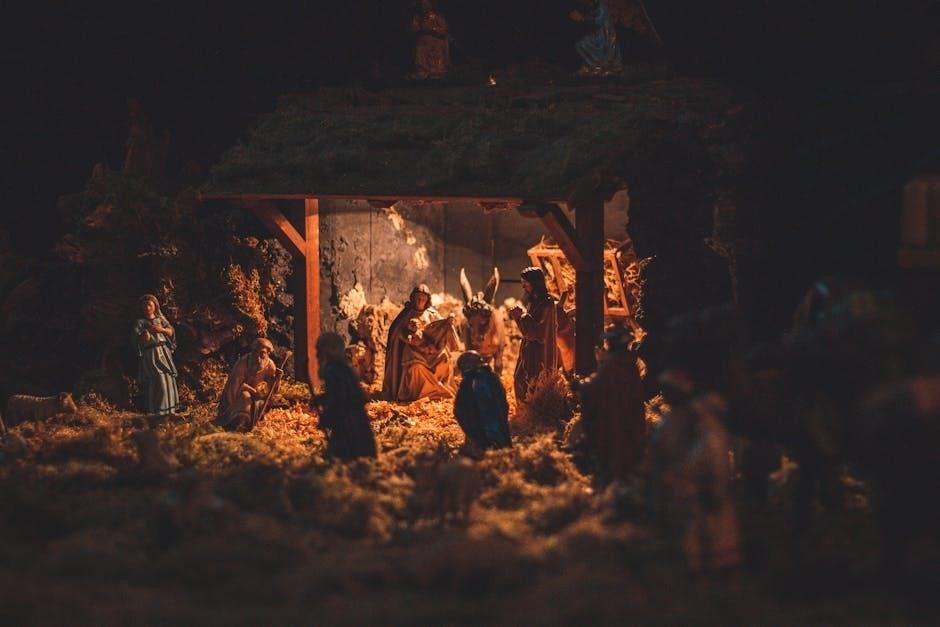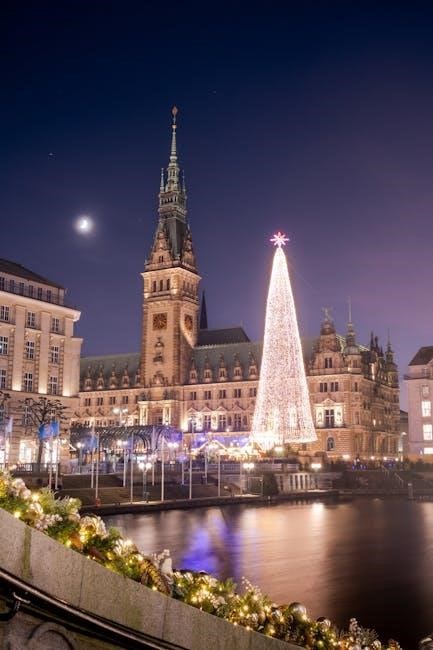The Christmas story, deeply rooted in Christian tradition, recounts the birth of Jesus Christ, emphasizing themes of divine love, hope, and redemption․ It centers on Mary, Joseph, and the angel Gabriel, highlighting the miraculous conception and Jesus’ birth in Bethlehem․ This narrative has become a cornerstone of religious and cultural celebrations worldwide, symbolizing peace and joy․
1․1 Overview of the Christmas Narrative
The Christmas narrative revolves around the birth of Jesus Christ, detailing the events leading to His arrival in Bethlehem․ It begins with the annunciation to Mary by the angel Gabriel, announcing she would bear God’s Son․ Mary and Joseph, her betrothed, journey to Bethlehem for a census, where Jesus is born in a manger․ The story also includes the visit of the Magi, wise men guided by a star, who come to worship the newborn King․ This narrative is a cornerstone of Christian faith, symbolizing love, hope, and redemption, and is celebrated globally with profound cultural and religious significance․

1․2 Historical Context of Christmas
Christmas, as a celebration, has its roots in early Christianity, commemorating the birth of Jesus Christ․ The holiday gained prominence in the 4th century under Emperor Constantine, who declared December 25 as Jesus’ birthday to align with existing Roman festivals․ Early traditions blended Christian rituals with pre-Christian customs, creating a unique cultural and religious observance․ The historical context highlights the evolution of Christmas from a modest religious event to a global celebration, influenced by various cultures and traditions over centuries․ This transformation underscores the holiday’s adaptability and enduring significance in both religious and secular contexts․
1․3 Cultural Significance of Christmas
Christmas holds profound cultural significance, transcending its religious origins to become a universal celebration of joy, unity, and generosity․ It is a time for family gatherings, gift-giving, and festive traditions, fostering a sense of community and togetherness․ The holiday has inspired countless works of literature, music, and art, embedding it deeply into global culture․ Beyond its religious meaning, Christmas symbolizes hope, renewal, and the spirit of giving, making it a cherished event for people of all backgrounds․ Its cultural impact is evident in the widespread adoption of traditions like decorating trees, singing carols, and exchanging gifts, creating a shared experience worldwide․
The Biblical Account of Christmas
The biblical account of Christmas narrates the miraculous birth of Jesus Christ, beginning with the angel Gabriel’s annunciation to Mary and culminating in Jesus’ birth in Bethlehem․
2․1 The Annunciation to Mary
The Annunciation to Mary is a pivotal moment in the Christmas story, where the angel Gabriel announces to Mary that she will bear a son, Jesus, the Son of God․ This divine message, delivered in Nazareth, astonishes Mary, who humbly accepts the will of God․ The angel reassures her, explaining that the Holy Spirit will overshadow her, making the conception possible․ Mary’s response, “Behold, I am the servant of the Lord,” reflects her faith and obedience․ This event marks the beginning of the fulfillment of Old Testament prophecies and sets the stage for the miraculous birth of Jesus, emphasizing God’s plan of salvation․
2․2 The Journey to Bethlehem
The journey to Bethlehem was a pivotal event in the Christmas story, driven by a Roman Empire decree requiring a census․ Mary and Joseph, residing in Nazareth, were compelled to travel to Joseph’s ancestral home, Bethlehem․ The journey was arduous, with Mary being heavily pregnant․ Upon arrival, the town was crowded, and all lodging was occupied, leading to their stay in a humble manger․ This challenging journey underscores their faith and obedience, setting the stage for Jesus’ birth in a simple, unexpected setting, fulfilling ancient prophecies and highlighting the humble beginnings of the Messiah․
2․3 The Birth of Jesus
The birth of Jesus is the centerpiece of the Christmas story, marking the fulfillment of divine prophecy․ In a humble manger in Bethlehem, Mary gave birth to Jesus, wrapping him in swaddling clothes․ The circumstances were far from grand, reflecting the simplicity and humility of the event․ An angel announced Jesus’ birth to nearby shepherds, who hurried to worship him․ This moment symbolizes God’s love and redemption, as Jesus, the Messiah, entered the world in a lowly setting, embodying grace and hope for humanity․ The birth of Jesus remains a profound symbol of divine love and the promise of salvation․
2․4 The Visit of the Magi
The visit of the Magi, also known as the Three Wise Men, is a significant event in the Christmas story․ These scholars, likely from Persia, followed a miraculous star to Bethlehem, guided by their knowledge of ancient prophecies․ Upon finding Jesus, they worshipped him, offering gifts of gold, frankincense, and myrrh, symbolizing royalty, priesthood, and sacrifice․ Their journey highlights the universal appeal of Jesus’ birth, as Gentiles recognized his divine significance․ This visit underscores the cosmic and spiritual dimensions of the Christmas narrative, showing that Jesus’ arrival was not just for Israel but for all humanity, fulfilling prophecy and revealing God’s plan of redemption․

Key Characters in the Christmas Story
Mary, the mother of Jesus, Joseph, her devoted husband, the angel Gabriel, and the Three Wise Men are central figures in the Christmas narrative, each playing a vital role in the birth and recognition of Jesus as the Messiah․

3․1 Mary, the Mother of Jesus
Mary, a young, devout Jewish woman, is central to the Christmas story․ The angel Gabriel announced to her that she would bear Jesus, the Son of God, through the Holy Spirit․ Her humble acceptance, “I am the Lord’s servant,” exemplifies her faith and obedience․ Mary’s visit to her cousin Elizabeth, who recognized the Messiah in her womb, further highlights her pivotal role․ Her courage and perseverance amidst challenges underscore her character․ Mary’s nurturing of Jesus and her presence at key events in his life solidify her significance․ Her story symbolizes divine grace and maternal love, inspiring reverence across cultures and centuries․
3․2 Joseph, the Husband of Mary
Joseph, a righteous and compassionate carpenter, plays a vital role in the Christmas story․ Engaged to Mary, he faced an unexpected challenge when she conceived Jesus through the Holy Spirit․ Initially perplexed, Joseph received divine guidance through an angel in a dream, affirming the miraculous nature of Mary’s pregnancy․ His unwavering faith and obedience led him to protect and support Mary, ensuring her safety and well-being․ Joseph’s journey to Bethlehem and his role in Jesus’ early life highlight his commitment to family and divine purpose․ His selfless love and trust in God exemplify the qualities of an ideal earthly father, making him a cornerstone of the Holy Family’s story․
3․3 The Angel Gabriel
The Angel Gabriel is a central figure in the Christmas story, serving as God’s divine messenger․ He appears to Mary in Nazareth, announcing that she will bear Jesus, the Son of God․ Gabriel’s message, “Peace be with you!” and his declaration of God’s favor, left Mary in awe․ Despite her initial confusion, Gabriel reassured her, explaining the miraculous conception through the Holy Spirit․ His role underscores the supernatural nature of Jesus’ birth, emphasizing God’s direct intervention․ Gabriel’s visit to Mary is a pivotal moment, marking the beginning of the divine plan for humanity’s redemption․ His presence symbolizes hope and divine guidance, making him a revered figure in the narrative․
3․4 The Three Wise Men
The Three Wise Men, or Magi, are pivotal figures in the Christmas story, representing wisdom and devotion․ They followed a celestial star to Bethlehem, guided by divine signs, to pay homage to the newborn Jesus․ Bearing gifts of gold, frankincense, and myrrh, these offerings symbolized Jesus’ kingship, divinity, and mortality․ Their journey, as recorded in the Bible, highlights their recognition of Jesus as the Messiah․ The Magi’s visit underscores the universal appeal of the Christmas narrative, bridging cultural and religious boundaries․ Their story embodies the themes of faith, generosity, and the pursuit of truth, making them enduring symbols of the season․

The Historical and Religious Significance
The Christmas story fulfills ancient prophecies, marking Jesus’ birth as a divine act of redemption․ It’s central to Christian theology, symbolizing God’s love and humanity’s salvation․
4․1 The Birth of Jesus as a Fulfillment of Prophecy
The birth of Jesus is deeply intertwined with ancient prophecies, fulfilling predictions made centuries earlier in the Old Testament․ The prophet Micah foretold Jesus’ birth in Bethlehem, while Isaiah prophesied His virgin birth․ These prophecies were central to Jewish expectations of a Messiah․ The angel Gabriel’s announcement to Mary and Joseph confirmed these divine promises, marking Jesus’ arrival as a fulfillment of God’s plan․ This event symbolized redemption and hope, aligning with scriptural forecasts of a savior․ The convergence of prophecy and reality in Jesus’ birth underscores its significance as a divine act of love and redemption for humanity․
4․2 The Role of Christmas in Christian Theology
Christmas holds profound theological significance in Christianity, celebrating the Incarnation of God through Jesus Christ․ It embodies the divine act of love, where God became human to redeem humanity from sin․ The birth of Jesus represents the fulfillment of God’s promise of salvation, central to Christian doctrine․ This event underscores the themes of grace, redemption, and divine love, forming the foundation of Christian faith․ Christmas serves as a reminder of God’s plan to reconcile humanity with Himself, making it a pivotal moment in Christian theology and a celebration of eternal hope and spiritual renewal for believers worldwide․
Christmas Traditions and Celebrations
Christmas traditions include decorating trees, exchanging gifts, and family gatherings, symbolizing joy, love, and hope․ These customs reflect the spirit of togetherness and celebration worldwide․
5․1 The Origin of Christmas Traditions
Christmas traditions trace their roots to the biblical account of Jesus’ birth, blending religious and cultural practices․ Early celebrations included Nativity scenes, symbolizing the manger and Bethlehem․ Over time, customs like decorating trees and exchanging gifts emerged, reflecting themes of joy and generosity․ These traditions, deeply intertwined with the Christmas story, have evolved into global celebrations, preserving the essence of love and hope central to the narrative․
5․2 Modern-Day Celebrations Around the World
Christmas is celebrated globally with diverse traditions, blending cultural and religious practices․ In Germany, Christmas markets and festive lights dominate, while Italy focuses on Nativity scenes and family feasts․ Mexico’s Posada celebrations reenact the journey to Bethlehem, and in Japan, Christmas is marked with illuminated displays and KFC meals․ Ethiopia observes Christmas with a unique hockey-like game called Ganna․ These modern celebrations reflect the universal appeal of the Christmas story, adapting its message of joy and hope to local customs and traditions, creating a rich tapestry of global observance․
5․3 The Role of Family and Gift-Giving
Family and gift-giving are central to Christmas celebrations, reflecting the story’s themes of love and generosity․ The tradition of exchanging gifts symbolizes the Magi’s offerings to Jesus and expresses gratitude and affection․ Families often gather for festive meals, reinforcing bonds and creating lasting memories․ In many cultures, children receive gifts, evoking the joy of the Nativity․ The act of giving mirrors the divine gift of Jesus, emphasizing selflessness and kindness․ This practice, rooted in the Christmas story, continues to inspire modern celebrations, blending spiritual significance with heartfelt connections, making it a cornerstone of holiday traditions worldwide․

The Christmas Story in Literature and Media
The Christmas story has inspired countless literary works and film adaptations, such as A Christmas Carol and A Christmas Story, capturing its timeless themes and spirit․
6․1 Classic Christmas Stories and Novels

Classic Christmas stories and novels have captivated audiences for generations, offering timeless themes of love, hope, and redemption․ Works like A Christmas Carol by Charles Dickens and A Christmas Story by Jean Shepherd have become staples of holiday literature․ These narratives often explore the spiritual and emotional essence of Christmas, resonating with readers worldwide․ The story of Mary, Joseph, and the birth of Jesus, as detailed in Christmas Story PDF, has also inspired numerous literary adaptations, blending religious significance with cultural traditions․ These stories, whether in print or film, continue to enrich the holiday season with their enduring messages of joy and compassion․
6․2 Film Adaptations of the Christmas Story
Film adaptations of the Christmas story have brought the narrative to life for audiences worldwide․ Movies like A Christmas Story (1983) and A Christmas Carol (2009) capture the essence of the season, blending tradition with modern storytelling․ These films often highlight key elements of the Christmas story, such as the birth of Jesus, the journey of Mary and Joseph, and the visit of the Magi․ By visualizing these events, films make the story accessible and engaging for new generations․ They also incorporate cultural and emotional depth, ensuring the Christmas story remains relevant and inspiring in contemporary times․
The Christmas Story in Art and Music
The Christmas story is vividly depicted in art through Nativity scenes and in music with carols like Last Christmas, blending tradition and emotion to inspire reflection and joy․
7․1 Depictions of the Nativity Scene
The Nativity scene, a central element in Christmas art, portrays the birth of Jesus in Bethlehem․ It typically features Mary, Joseph, the baby Jesus, shepherds, and the Magi, often with angels and animals․ Artistic depictions vary across cultures, from Renaissance masterpieces to modern interpretations, reflecting diverse styles and symbolism․ These scenes are often displayed in churches, homes, and public spaces during Christmas, serving as a visual reminder of the story’s spiritual significance․ The Nativity scene has become a universal symbol of peace, hope, and divine love, transcending artistic mediums to inspire devotion and reflection․
7․2 Christmas Carols and Hymns
Christmas carols and hymns are integral to the festive season, capturing the spirit of joy, faith, and celebration․ Traditional carols like Silent Night and Joy to the World have been sung for centuries, while modern compositions, such as Last Christmas by Wham!, have become global favorites․ These songs often recount the Christmas story, emphasizing themes of love, hope, and redemption․ Many carols, like The First Noel and Hark! The Herald Angels Sing, draw directly from biblical narratives, making them a powerful way to share the story of Jesus’ birth․ Their melodies and lyrics evoke emotions, uniting people across cultures and generations in celebration of the season․

The Christmas Story in Different Cultures

Christmas traditions vary globally, blending local customs with the biblical narrative․ From Germany’s Nativity scenes to Italy’s presepi, each culture uniquely celebrates the birth of Jesus, reflecting diverse heritage while preserving the story’s essence․
8․1 Unique Christmas Traditions Globally
Christmas traditions worldwide reflect cultural diversity while honoring the biblical narrative․ In Germany, festive markets and Nativity scenes dominate, while Italy showcases intricate presepi․ Spain celebrates with parades and midnight Mass․ In Mexico, Posadas reenact Mary and Joseph’s journey, blending faith with vibrant festivities․ Japan uniquely combines Christmas with New Year traditions, often dining on Kentucky Fried Chicken․ Iceland’s Yule Lads bring gifts over 13 nights, adding a mythical touch․ These customs, though varied, share a common thread—celebrating the birth of Jesus with joy, family, and cultural flair, illustrating how the Christmas story adapts beautifully across global cultures․
8․2 Cultural Variations in Celebrating Christmas
Christmas celebrations vary widely across cultures, blending local traditions with the biblical narrative․ In Germany, festive markets and Nativity scenes are central, while Italy focuses on presepi, intricate Nativity displays․ Spain and Latin America celebrate with parades, fireworks, and midnight Mass․ Mexico honors the journey of Mary and Joseph with Posadas, reenacting their search for shelter․ In Japan, Christmas is often marked with Kentucky Fried Chicken, a modern twist, while Iceland’s Yule Lads bring gifts over 13 nights․ These cultural adaptations highlight how the Christmas story is embraced and personalized worldwide, reflecting diverse traditions and values while maintaining its spiritual core․
The Christmas Story and Its Message
The Christmas story embodies divine love, hope, and redemption, offering a universal message of peace and joy that transcends cultures and time․
9․1 Themes of Love, Hope, and Redemption

The Christmas story profoundly highlights themes of love, hope, and redemption․ Mary’s unwavering faith and Joseph’s steadfast support exemplify divine love․ The birth of Jesus embodies hope, fulfilling ancient prophecies and promising salvation․ Through this narrative, redemption is central, as Jesus’ arrival signifies God’s plan to save humanity․ These themes resonate universally, offering comfort and inspiration across generations․ The story’s message of love and hope transcends time, reminding humanity of the transformative power of faith and grace․
9․2 The Universal Appeal of the Christmas Story
The Christmas story’s universal appeal lies in its timeless themes of love, hope, and redemption, transcending cultural and religious boundaries․ Its message of divine love, embodied in the birth of Jesus, resonates with people worldwide․ The narrative’s simplicity and profound meaning make it accessible to all, regardless of background․ The story’s emphasis on hope and renewal inspires individuals, offering a sense of joy and optimism․ Its global presence in literature, music, and art further underscores its universal impact, making it a cherished tale for millions․ This enduring appeal ensures the Christmas story remains a unifying force across generations and cultures․
The Christmas story’s enduring legacy lies in its timeless message of love, hope, and redemption, inspiring generations and cultures worldwide with its universal appeal and profound significance․
10․1 The Enduring Legacy of the Christmas Story
The Christmas story’s legacy endures as a timeless narrative of love, hope, and redemption, transcending cultures and generations․ Its depiction in art, literature, and media continues to inspire, while its themes of divine grace and universal love resonate deeply․ The story’s influence is evident in global traditions, from nativity scenes to carols, each reflecting its profound impact․ As a symbol of peace and joy, the Christmas story remains a unifying force, adapting to modern contexts while retaining its spiritual core․ Its enduring appeal lies in its ability to evoke emotions and foster connections, ensuring its relevance for centuries to come․
10․2 The Relevance of Christmas in the Modern World
Christmas remains a deeply relevant and unifying celebration in the modern world, transcending religious boundaries to inspire joy, kindness, and reflection․ Its themes of love, generosity, and hope resonate universally, fostering connections across cultures․ In an increasingly fast-paced and fragmented society, Christmas offers a moment for families and communities to pause, reflect, and reconnect․ The story’s message of peace and goodwill continues to inspire charitable acts and global unity․ Even in secular contexts, the holiday’s spirit of giving and togetherness endures, making it a timeless and enduring part of human experience, adapting to contemporary life while retaining its core values․
